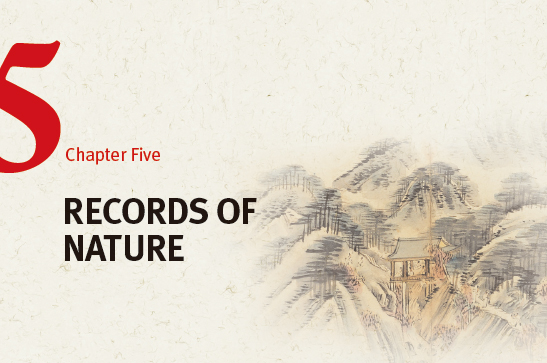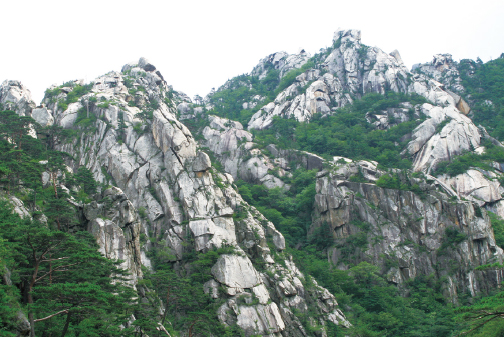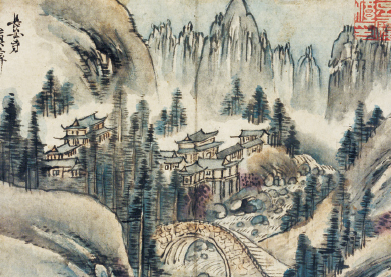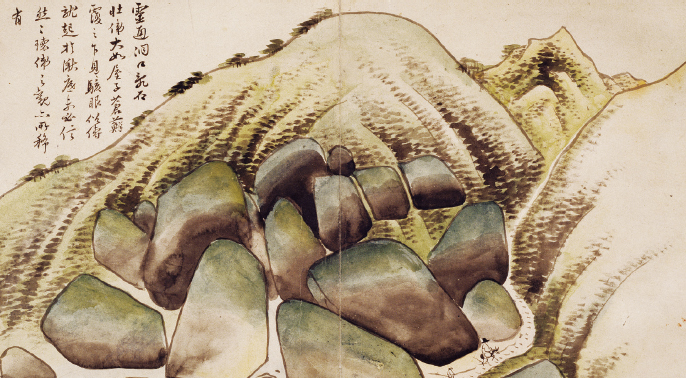
“In Korea, landscape painting—rather than figure paintings or historical paintings as in the Western world—became the preeminent form in part because nature itself was considered sacred. Nature was seen as a living entity. It symbolized both an integral part of human life and a higher spiritual being. Such a conception of nature was shared also by China and Japan, with each culture developing its own variations of the philosophy and related rituals. Given the lofty ideals attached to it, transferring this vast and superior nature or landscape onto a two-dimensional surface posed a challenge to artists that in turn elevated the position of landscape painting.”
Soyoung Lee, Asia Society, Aug. 20, 2008
In Korean painting of the Joseon era, the landscape was regarded as the highest form of the art. As noted above, this is largely the product of the Korean world view—nature is sacred, and mankind is just one part of it. Another important reason was the hegemony of Neo-Confucianism in Joseon society. Confucianism, with its emphasis on humility, encourages an aesthetic that treats the human form—and even man made objects—as purely secondary. For this reason, the landscape painting achieved high status, first in Song China, where the beautiful natural landscapes became a metaphor for the well-ordered state. So it was in Korea, too, which at any rate had taken to adopting Chinese painting forms in the Joseon era.

Clearing after Rain on Mt. Inwangsan. Jeong Seon started painting actual Korean landscapes rather than idealized versions of Chinese landscapes. (Jeong Seon, 1751, Leeum, Samsung Museum of Art)
For the Confucian elite, landscape painting also went beyond a mere art: it was a form of scholarly and spiritual discipline. By evoking the work of past masters, the painter evoked the values of the past as well, while at the same time expressing his own spirit through the brushwork and his own interpretation of ancient scenes.
In the early Joseon era, landscapes tended to hew much closer to the Chinese model. A common theme in this period was the Eight Views of the Xiao and Xiang Rivers, a beautiful region in southern China. This theme developed in the Song Dynasty China of the 11th century and became hugely popular in Korea in the 15th and 16th centuries. In the latter part of the Joseon era, beginning in the 18th century, Korean artists—led by the master Jeong Seon (1676-1759)—started painting actual Korean landscapes rather than idealized versions of Chinese landscapes. Scenic locations such as the Mt. Geumgangsan in what is now North Korea became a favored subject. Also, the educated elite preferred to fill in the colors with their own imaginations.
REALISTIC LANDSCAPE PAINTING
The distinguished late Joseon Kingdom Kim scholar-cum-calligrapher Kim Jeong-hui (1786-1856) once described the artistic process as follows: “The brain moves the arm, the arm moves the hand, and the hand moves the brush” For Kim, the artist’s mind, his thoughts, were what determined his paintings or calligraphy. Thus, the differences we find in various paintings and works of calligraphy are attributable to the differences in each artist’s thought and personal style.
It is for this reason that the landscape paintings of the middle and late Joseon periods are so different from those of earlier periods. Realistic landscapes came to replace the more idealized works of the early Joseon period. This shift was the result of diverse intellectual changes that converged in the form of a clearer Korean cultural identity. For instance, the philosopher Yi I (1536-1584) pulled together different strands of Neo-Confucian thought to create a complete Korean system, helping his disciples launch a movement promoting a distinctly Korean philosophy; Jeong Cheol (1536-1593) wrote poetic masterpieces in hangeul, the indigenous Korean writing system, thus triggering a boom in Korean-language literature; and Han Seok-bong (1543-1605), one of Joseon’s most eminent calligraphers, developed his own distinctive style, which was later named after its creator.
This new tendency for scholars and artists to articulate their own ideas and styles prompted painters to depart from the previously unquestioned depiction of imaginary Chinese landscapes in the Chinese style. They began to portray real Korean landscapes that they could see with their own eyes, thus revolutionizing Joseon period painting.
In the arts, what matters is not what one paints, but how one paints a given object. The emergence of the realistic landscape school reflected an important change in both thought and style, which, in turn, brought about a revolution in artistic method.
LEADING ARTISTS
Jo Sok (1595-1668)
The pioneer of realistic landscape painting was Jo Sok (1595-1668). Jo toured scenic spots throughout the kingdom and expressed his impressions through poetry and painting. His ideas and artistic style were carried on and refined by his son, Jo Ji-un (1637-1691), and perfected by Jeong Seon (1676-1759).
Jeong Seon (1676-1759)
One of the most prolific and distinguished painters of the Joseon era, Jeong Seon was extremely active during his 83 years, and more than 500 of his works remain today. Thoroughly at home with the principles of the I Qing, or Book of Changes, and Neo-Confucianism, Jeong was an ardent traveller who toured the country rendering the beauty of Korean landscapes in his paintings. He was particularly interested in capturing the breathtaking beauty of Mt. Geumgangsan, which he visited seven times and depicted in hundreds of works. Jeong exceeded other painters not only in his zeal to depict uniquely Korean themes but also in his creativity of composition and style.
Kim Du-ryang (1696-1763)
A professional court painter affiliated with the Royal Academy of Painting (Dohwaseo), Kim Du-ryang left many fine landscape paintings such as Landscapes of the Four Seasons and Landscape in the Moonlight. Kim’s father and son were also court painters. Mountain and Stream under the Moonlight, a work depicting a secluded forest flooded in moonlight on a late autumn night, is a masterpiece overflowing with Korean atmosphere and emotion.
Yi In-sang (1710-1760)
Yi In-sang led a poor but honest life and left behind many works distinguished for their purity and freshness. His major works deal with themes such as scholars chatting under an enormous old tree, large trees and rocks, and a scholar seated beneath a pine tree enjoying a waterfall. These themes probably appealed to Yi because they reflected the pure and simple life he himself led. Yi also painted several works depicting Mt. Geumgangsan.

Mt. Geungangsan. Jeong Seon was particularly interested in capturing the breathtaking beauty of Mt. Geumgangsan, which he visited seven times and depicted in hundreds of works. (Jeong Seon, 1734, Leeum, Samsung Museum of Art)
WHY THE MT. GEUMGANGSAN?
Koreans love the Mt. Geumgangsan. It is said that the peaks were famous as a Buddhist pilgrimage ground in the 13th century: if you set foot in the mountains only once, it was thought you wouldn’t go to hell. The mountains weren’t an easy place to get to, however: people at the time would say that if you had no time, money, or health, you couldn’t go. Accordingly, you were considered very fortunate if you managed to make it to the scenic peaks even once in your life. People who had visited the mountains kept paintings of the peaks to commemorate their trip, while those who hadn’t kept paintings of the mountains to ease their longing to see the peaks.
The Mt. Geumgangsan are known by many names. In spring, when the peaks shimmer, they are called the Mt. Geumgangsan (Diamond Mountains). In summer, when they turn green, there are called Bongraesan, referring to the mythical peak where the Taoist spirits live. In autumn, when their maples turned bright red, they are called Pungaksan (Autumnal Foliage Mountain), and in winter, when the bare stone peaks are topped with snow, they are called Gaegolsan (Skeleton Mountain).

Kim Yun-gyeom (1711-1775)
Few painters can match Kim Yun-gyeom in their devotion to the realistic landscape genre. In fact, Kim painted nothing else. He is believed to have learned his art from Jeong Seon, since his method of depicting rocks and pine trees is similar to Jeong’s. However, Kim developed a distinct style best characterized by his tendency to emphasize certain elements of an object while omitting other details, his variation on the diagonal composition technique, and his three-dimensional portrayal of rocks using diluted ink and watercolors.
Gang Hui-eon (1710-1784)
Gang Hui-eon also lived near Jeong Seon, was 34 years his senior, and was in close contact with two other painters representative of 18th century landscape painting: Gang Se-hwang and Kim Hong-do. The two Gangs were distant relatives and influenced each other artistically. Gang Hui-eon came to associate with Kim through Gang Se-hwang. Thus, Gang Hui-eon mingled with many of the very best painters of his era, a period of cultural renaissance. If a painter’s work is not only an expression of his own artistic world but also a representation of the spirit of his time and regional characteristics, then Gang’s Mt. Inwangsan must represent both the realistic landscape painting style he embraced and the spirit of the Silhak (Practical Learning) School, which blossomed in the 18th century.

Mt. Bongraesan (Kim Yun-Gyeom, 1786, National Museum of Korea)
Gang Se-hwang (1712-1791)
The greatest of the 18th century painters was Gang Se-hwang, a versatile artist skilled not only at landscapes but also at paintings of the “four gentlemen” (bamboo, plum blossoms, chrysanthemums, and orchids), birds, and flowers, and a gifted poet. Gang left an indelible mark on the history of Korean painting with his Travels to Songdo, an album of paintings depicting actual landscapes in Songdo (now Gaeseong in North Korea). Gang’s creativity and distinctive style are revealed in this album through his harmonization of a literati painting style, bold and unrestrained brushwork, and the use of fresh colors reminiscent of a Western-style watercolor.

Entryway to Yeongtongdo from Album of Journey to Songdo. A Journey to Songdo is an album of paintings depicting actual landscapes in Songdo. (Gang Se-hwang, 18th C, National Museum of Korea)
Choe Buk (1712-?)
Choe Buk is known to have been an eccentric artist. Fresh data on his life and work have been uncovered recently, encouraging new research and a reevaluation of his artistic achievements. His major works, including Landscape in Autumn, A Deserted Mountain, and Viewing the Waterfall Under a Tree, are all excellent paintings.
LANDSCAPE PAINTING IN THE WEST AND EAST
While Western and Eastern art have long traditions of landscape painting, there are very real differences in the two traditions.
Interestingly, for much of their histories landscape paintings in the East and West did share a commonality: idealized scenes. When landscape painting started reappearing in Europe in the 15th century, it focused primarily on idealized pastoral scenes from the Italian countryside; even painters who had never been to Italy painted them. In China—and by extension, the rest of East Asia—landscape painters focused on idealized landscapes of the region between the Xiao and Xiang Rivers in China.
Eastern landscapes, however, are not meant to be depictions of an exterior scene. Rather, they are representations of the artist’s mind, a retreat from society into the divine perfection of nature. Western landscapes, by contrast, represent scenes or historical moments, usually with a prominent human presence. In fact, in many Western landscapes it seems as if mankind “partners” with nature, where nature itself is not being personified, in stark contrast to the Eastern landscape, where mankind is very much “part” of nature, and a small part at that.
Kim Eung-hwan (1742-1789)
Kim Eung-hwan’s work is also distinguished by its artistic originality. The eldest son of a Gaeseong family of first-class artists, Kim had a strong influence over his nephews, Kim Deok-sin, Kim Seok-sin, and Kim Yang-sin, as well as his sons-in-law, Chang Hanjong and Yi Myeong-gi. Kim produced dozens of landscapes depicting Mt. Geumgangsan, including Album of Mt. Geumgang san Paintings which is extant today.
Kim Hong-do (1745-?)
An extraordinarily gifted painter, Kim Hong-do is better known as a portrait artist or genre painter than as a landscape artist. However, he produced many landscapes. In fact, his paintings of Mt. Geumgangsan equal Jeong Seon’s in both quantity and quality. Kim is said to have produced 40 or 50 paintings of the mountain at one time, which he then placed in an album. Three such albums survive today, testifying to his skill as a landscape painter. Indeed, the near-perfect composition, the impeccable harmony of rocks, trees, and human figures, and the realistic portrayal of the landscapes found in Kim Hong-do’s landscape paintings are almost mystical.
Yi In-mun (1745-1821)
Yi In-mun, a contemporary of Kim Hong-do, was also a superb painter of landscapes. Although he mastered a variety of Chinese styles and even practiced them from time to time, Yi was basically an artist of the mid-18th century; like other artists of that era, he followed the prevailing realistic landscape aesthetic. Prior to the age of 60, Yi generally produced neat, clean works using fine brushstrokes; however, in his later years, he relied on more vigorous, rougher brushwork to produce works that transcended secular norms. Extant examples of these more masculine works include: Pleasant Talks Under a Pine Tree; A Gentlemen’s Gathering; Leisurely Talks Under a Pine Tree; Mt. Geumgangsan; Snowy Landscape; and Landscape in Summer.

Mountains and Rivers without End (Yi In-mun, 18th C, National Museum of Korea)
Kim Deok-sin, Kim Seok-sin, and Kim Yang-sin
The three Kim brothers—Deok-sin, Seok-sin, and Yang-sin—were the last major painters in the realistic landscape tradition. While they learned from Jeong Seon and Kim Eung-hwan, the Kims pursued their own styles. Although they were affiliated with the Royal Academy of Painting, they did not limit themselves to schematic or bureaucratic work. Armed with a new way of thinking and a new style befitting their times, they transcended the bounds of court painting to enrich the landscape tradition they had inherited.